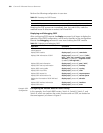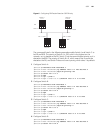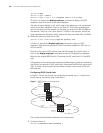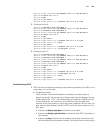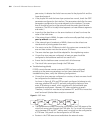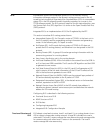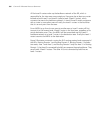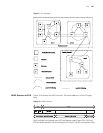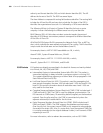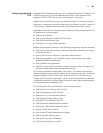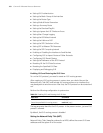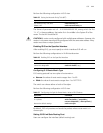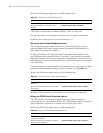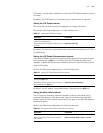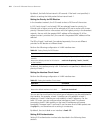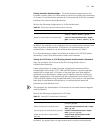108 CHAPTER 5: IP ROUTING PROTOCOL OPERATION
authority and format identifier (AFI) and initial domain identifier (IDI). The AFI
defines the format of the IDI. The DSP has several bytes.
The Area Address is composed of routing field and area identifier. The routing field
includes the AFI and the IDI and may also include the first byte of the DSP. It
identifies the organizational structure. It is followed by a 16-bit area identifier.
The following 48 bits (or 6 bytes) of System ID identifies the host or router
uniquely. A router that belongs to different areas has only one identifier.
NSAP Selector (SEL) of 8 bits does not select routes but equals the protocol
identifier of IP. Different transmission protocols correspond to different identifiers.
All the SELs of IP are 00.
AFI+IDI+HO-DSP+System ID+SEL composes the Network Entity Title, or NET for
short, which indicates the area address and system ID for routing. The ID should be
unique inside the whole area and on the backbone (Level-2).
For example, there is a NET 47.0001.aaaa.bbbb.cccc.00, in which,
Area=47.0001, System ID=aaaa.bbbb.cccc, SEL=00.
For example, there is a NET 01.1111.2222.4444.00, in which,
Area=01, System ID=1111.2222.4444, and SEL=00.
IS-IS Packets IS-IS packets are directly encapsulated in the data link frames and mainly divided
into 4 kinds, IIH, LSP,
CSNP, and PSNP.
■ Intermediate System to Intermediate System Hello PDU (IIH). This packet is
transmitted regularly to detect whether a contiguous system is running IS-IS
This supports establishing adjacency and allows data to be propagated in Link
State Protocol Data Units (LSPs).
■ Link State Protocol Data Unit (LSP). This packet is used for propagating link
state records throughout the area. LSPs includes Level-1 LSPs and Level-2 LSPs.
Level-2 LSPs contain information about all reachable areas. Level-1 LSPs are
only used for the local area.
■ Complete Sequence Numbers Protocol Data Unit (CSNP). CSNP includes Level-1
CSNP and Level-2 CSNP. The CSNP is used for database synchronization. The
DIS transmits to CSNPs (every 10 seconds by default) regularly on the broadcast
network. Over the p2p serial line, the CSNP is transmitted only when the
adjacent relationship is established for the first time.
■ Partial Sequence Numbers Protocol Data Unit (PSNP). PSNP includes Level-1
PSNPs and Level-2 PSNPs. The PSNP supports the database synchronization.
Over the p2p link, the routers transmit PSNP as Ack response to acknowledge
the receipt of a certain LSPs. Also, if a router finds, from the received CSNP, that
it is missing some data (or the original database is older), it will transmit a PSNP
requesting a new LSP.
For more information, refer to relevant documentation, such as ISO 10589.



